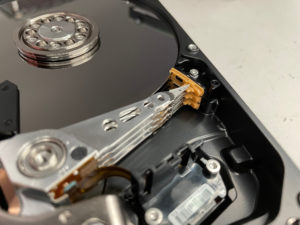
The read/write heads of a hard drive in a resting position.
If you’re of a certain age, you learned that defragmenting your hard drive was important computer hygiene. That’s no longer the case — or, at least, you don’t need to manually defragment your HDD.
Modern operating systems, especially Windows (versions 7, 10, and 11) and macOS, automatically handle this process for you in the background. And given that modern operating systems are pushing users towards solid-state drives (SSDs), even that type of defragmentation is becoming unnecessary.
While you don’t need to do anything, the process itself is still important for older mechanical drives. Below, we’ll explain what defragmentation is, why your computer still does it, and why you must never defragment a solid-state drive (SSD).
What Is Disk Fragmentation, Anyway?
Hard drives can store data sequentially, but data doesn’t always stay sequential. When a traditional hard disk drive (HDD) is new, your operating system writes files in continuous blocks.
But as you use the computer, you create, edit, and delete files. When you delete a file, it leaves an empty space on the drive. As you save new files, the OS will try to fill that empty space. If the new file is larger than the space, the OS will fill that first gap and then write the rest of the file in the next available empty space, which could be on a completely different part of the drive’s spinning platters.
Over time, a single large file (like a video game or a large document) can end up stored in dozens or even hundreds of different physical locations. That’s called fragmentation, and it’s an efficiency issue.
An HDD uses a physical arm, called a read/write head, to access data from the spinning platters. When a file is fragmented, this head has to physically jump all over the drive to collect every single piece of the file. This movement (or seek time) takes time and is what causes a fragmented drive to feel slow.
Defragmentation (or “defragging”) reorganizes all of those scattered pieces. The utility reads the fragmented files and rewrites them into a single, contiguous block, which allows the read/write head to access the entire file with minimal movement. Less movement means faster read times (and better performance).
On Modern Computers, Defragmentation Is Handled Automatically
In the days of Windows 98 and XP, manually defragmenting your drive was a common maintenance task. If you were around in those times, you probably remember waiting for hours for the utility to run — fortunately, that’s no longer necessary (although there is a website set up to recreate that “experience,” if you miss it for some reason).
Modern operating systems include a built-in drive maintenance tool (in Windows, it’s called Optimize Drives). This tool runs automatically on a schedule, usually once a week, often in the middle of the night when the computer is idle).
Optimize Drives identifies what type of drive it’s looking at and performs the correct action.
- For HDDs: It performs a traditional defragmentation to keep performance snappy.
- For SSDs: It performs a completely different, but equally necessary maintenance task, which is slightly outside of the scope of this article (though we’ll provide a bit more detail in a moment).
As long as your OS is set up for automatic drive optimization, there is no performance benefit to running a manual defrag. It’ll just slow your whole system down.
Don’t Defragment Solid-State Drives (SSDs)
You should never run a traditional defragmentation on a solid-state drive (SSD).
An SSD is not a mechanical drive, and it has no moving parts. It uses NAND flash memory, which is essentially a grid of millions of memory cells. An SSD can access any piece of data at the exact same near-instantaneous speed, no matter where it’s physically located.
In other words: Fragmentation doesn’t matter. It has zero impact on an SSD’s performance, and defragging an SSD is actively harmful:
- Limited Lifespan: Flash memory cells have a finite number of write cycles before they wear out.
- Intensive Writing: Defragmentation is an extremely write-heavy process. It works by reading data and rewriting it to a new location, over and over again.
Running a defrag on an SSD wastes write cycles, so it’s a pointless exercise.
Fortunately, the “Optimize Drives” tool in Windows knows this. When it detects an SSD, it does not defragment it. Instead, it runs a command called TRIM, which allows the SSD’s internal controller to properly manage its space and maintain high speeds.
As we’ve previously discussed, defragmenting a solid-state drive is a bad idea that wears out the components. Your operating system’s built-in optimizer will handle the correct maintenance (TRIM) for you.
Note: If your computer is running extremely slow or you suspect a drive is failing (you hear clicking, grinding, or buzzing from an HDD), do not run any disk utilities, especially defragmentation. The intense activity of a defrag can be the final push that causes a failing drive to crash completely, resulting in total data loss. Power the drive off immediately and seek professional advice.
Don’t Worry About HDD Defragmentation
You don’t need to defragment your hard drive; your computer already does it for you. Your operating system’s built-in tools are smart enough to defragment your HDDs for performance and run TRIM on your SSDs for health.
If a drive has already failed — whether it’s an SSD that won’t boot or an HDD that’s making clicking sounds — no software utility can fix it. At Datarecovery.com, our engineers work in ISO-certified cleanrooms with purpose-built systems to safely recover data from all types of failed drives. We offer risk-free evaluations and support all cases with our industry-leading “no data, no charge” guarantee.
If you’re facing data loss from any storage device, we’re here to help. Contact Datarecovery.com at 1-800-237-4200 for a free evaluation, or submit a case online.




